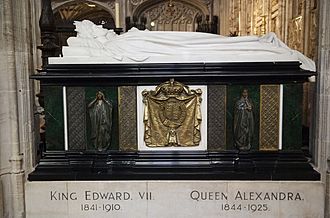Death and funeral of Alexandra of Denmark facts for kids

Tomb of King Edward VII and Queen Alexandra
|
|
| Date |
|
|---|---|
| Location |
|
| Participants | British royal family |
The funeral of Queen Alexandra took place on Friday, 27 November 1925, at Westminster Abbey. Queen Alexandra was the wife of King Edward VII and the mother of King George V. She passed away on 20 November 1925.
Contents
Queen Alexandra's Later Years
Queen Alexandra looked young even when she was older. However, during the First World War, her health started to decline. She stopped traveling to other countries. In 1920, she had an eye problem that caused her to be partly blind for a short time. Towards the end of her life, her memory and speech were not as good.
Her Final Moments
On 19 November, the day before she died, Queen Alexandra had a medical event around 11:00 am. By 1:00 pm on 20 November, her family arrived at Sandringham House. This included her three daughters and her grandson, Prince Henry. After her family arrived, she became unconscious.
She was given oxygen, but she continued to get weaker. Queen Alexandra died at 5:25 pm on 20 November 1925. She passed away from a heart attack at Sandringham House. She was just eleven days shy of her 81st birthday. Her son, King George V, and his wife, Queen Mary, were with her. Other members of the British royal family were also by her side.
Public Reaction to Her Death
After Queen Alexandra's death was announced, flags were flown at half-mast. This means they were lowered to show respect. However, at Windsor Castle, the Union Jack flag stayed at the top. This is because it is only lowered when the King or Queen dies.
Many events were cancelled to show respect. Hotels in London stopped their music and dance shows. The BBC also stopped its regular radio programmes. The Prime Minister, Stanley Baldwin, and the Leader of the Opposition, Ramsay MacDonald, both spoke in Parliament to share their sadness. Soldiers from the Grenadier Guards marched with their flags draped, showing their sorrow.
Funeral Arrangements
After her death, Queen Alexandra's body was first placed at St Mary Magdalene Church, Sandringham. Later, it was moved to the Chapel Royal in St James' Palace in London. A small service was held at the church in Sandringham. Members of the royal family and local villagers attended. People were also allowed to walk past her coffin to pay their respects.
Procession to London
Her coffin was covered with her special royal flag. It was taken in a procession from Sandringham to the local railway station. The King and Queen, along with other family members, followed the coffin. Estate workers and villagers also joined the procession.
In London, another procession took place. The coffin was moved from St James' Palace to Westminster Abbey. Soldiers lined the entire route. The procession passed famous places like The Mall and Whitehall. Different army groups took part in the procession. The coffin was placed on a special gun carriage. As it moved, gun salutes were fired.
Royal Mourners
Many important people walked behind the coffin. This included King George V, who wore a Field Marshal's uniform. Other kings from Europe were also there, such as the King of the Belgians, the King of Denmark, and the King of Norway. The Prince of Wales and the Crown Prince of Norway also walked in the procession.
The Queens and Princesses, including Queen Mary and the Queen of Norway, traveled directly to Westminster Abbey. Soldiers from the King's Company of Grenadiers helped carry the coffin.
The Funeral Service
The funeral service was held at Westminster Abbey on 27 November 1925, at 11:30 am. The service was led by the Archbishop of Canterbury. Many important guests attended, including government officials and ambassadors. The service included readings from the Bible, such as Psalm 23. Hymns like "Now the Laborer's Task is O'er" were also sung.
Lying-in-State and Burial
After the funeral service, Queen Alexandra's coffin was guarded by royal guards. She lay in state at Westminster Abbey. This meant that members of the public could come and see her coffin to pay their respects on 27 November.
Across the country, many churches held their own memorial services. Theatres and dance halls were closed. In Australia, memorial services were also held in major cathedrals.
Journey to Windsor
On 28 November, Queen Alexandra's coffin was taken to Windsor Castle. A private service was held there in the evening. Her coffin was placed next to her late husband's coffin. They were in front of the altar in the Albert Memorial Chapel. On 29 November, people visited Windsor to see the flowers left for Queen Alexandra.
Final Resting Place
After Edward VII died, his body was temporarily placed in the Royal Vault at Windsor. In 1919, Queen Alexandra asked for a special monument to be built. This monument was designed by Bertram Mackennal. It features statues of Edward and Alexandra made of white marble. These statues are on top of a black and green marble tomb.
Both Edward and Alexandra were buried in this tomb on 22 April 1927. This was two years after Alexandra's death. The monument also includes a statue of Edward's favorite dog, Caesar, lying at his feet.
Queen Alexandra's great-granddaughter, Princess Elizabeth Alexandra Mary of York, was born five months after Alexandra's death. Princess Elizabeth was named after her. She later became Queen Elizabeth II.
|

